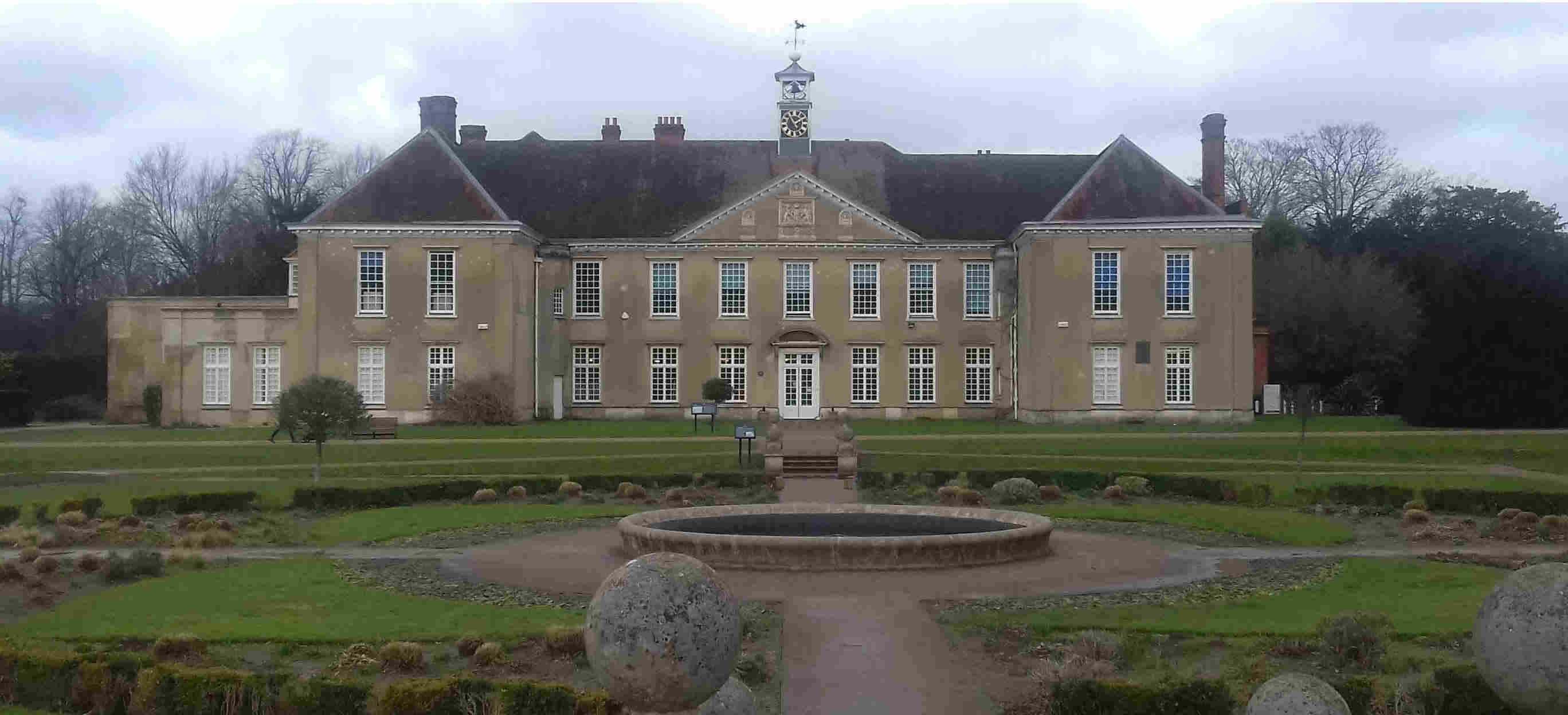Reigate and Redhill Remembers WW1
| Reigate and Banstead Council produced some working notes commemorating the First World War to celebrate the centenary of the war. These notes no longer appears on the RBBC website. With permission from the council, these notes are reproduced below. Please note some text relating to the 1914 celebrations has been deleted. |
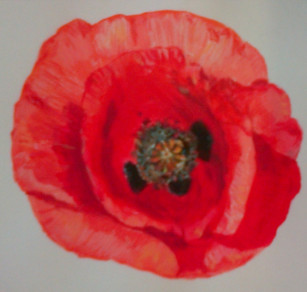 |
Reigate and Redhill Remembers
|
1914-1918 |
Volume 1 |
1914 |
 |
1914 |
||
Introduction from the Leader |
||
| Reigate & Banstead Borough Council is very proud of the part that our residents played in the First World War and determined that their bravery is remembered. Between 2014 and 2018 the Council is planning a range of activities and events across the borough so that people of all ages can come together to mark, commemorate and remember the lives of those who lived, fought and died in the First World War. We want to give people an understanding of what the Great War meant to the soldiers fighting, those left at home and how things changed as a result of the war. We wish to document these stories for future generations, so they are remembered. This publication would not be possible without the help of the local history societies and other local residents and our thanks go to all those involved. We want to hear your stories too, so please get in touch and let us know so they can be included in future editions. Signature Cllr Victor Broad Leader of Reigate and Banstead Borough Council |
||
How it started |
||
| Since 1815 the balance of power in Europe had been maintained by a series of treaties. In 1888 Wilhelm II was crowned ‘German Emperor and King of Prussia’ and moved from a policy of maintaining the status quo to a more aggressive position. He did not renew a treaty with Russia, aligned Germany with the declining Austro-Hungarian Empire and started to build a Navy rivalling that of Britain. These actions greatly concerned Germany’s neighbours, who quickly forged new treaties and alliances in the event of war. On 28 June 1914 Franz Ferdinand the heir to the Austro-Hungarian throne was assassinated by the Bosnian-Serb nationalist group Young Bosnia who wanted pan-Serbian independence. Franz Joseph the Austro-Hungarian Emperor (with the backing of Germany) responded aggressively, presenting Serbia with an intentionally unacceptable ultimatum, to provoke Serbia into war. Serbia agreed to eight of the ten terms and on the 28th July 1914 the Austro-Hungarian Empire declared war on Serbia, producing a cascade effect across Europe. Russia bound by treaty to Serbia declared war with Austro-Hungary, Germany declared war with Russia and France declared war with Germany. Germany’s army crossed into neutral Belgium in order to reach Paris, forcing Britain to declare war with Germany (due to the Treaty of London (1839) whereby Britain agreed to defend Belgium in the event of invasion). By the 4th August 1914 Britain and much of Europe were pulled into a war which would last 1,566 days, cost an estimated 10 million lives and 28,938,073 casualties or missing on both sides. |
||
Local troops
|
||
| The day after the declaration of war, 5th August 1914 “A” company of the 5th Battalion, Queens Royal West Surrey Regiment grouped at Reigate Drill hall. Just before 4pm the Mayor and Mayoress arrived and a lone bugle sounded as the men filed out to march to the railway station via Lesbourne Road, Bell Street, through the tunnel and up London Road. They assembled on the platform of Reigate Station and after a few choruses of popular songs, a train from Guildford took them to Canterbury the first stop that would end for some in India and others in Mesopotamia. The average age of these young men was 23. |
||
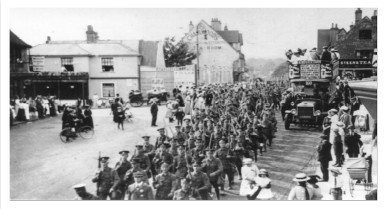 |
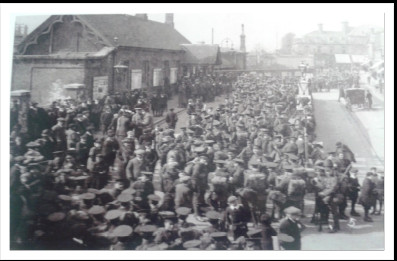 |
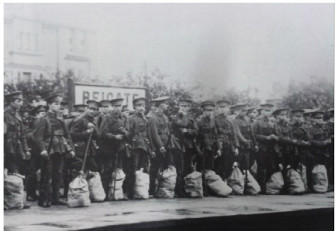 |
Thousands of troops march through Reigate |
“Soon after midday on September 9th 1914, the first bodies of troops entered Reigate and then onwards during the afternoon they were followed up by the remaining detachments of the body which made up the column” Surrey Mirror, September 11th 1914.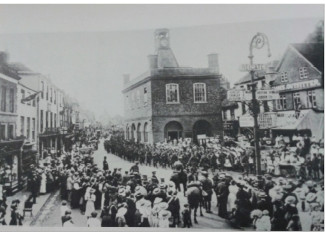 Many thousands of Territorials marched from Aldershot to Dover for embarkation to France and the Western Front. A few weeks before, they had been clerks, postmen, shopkeepers. As each Company, Battery or troop passed through the densely packed streets they were greeted with cheers of pride by the residents. Reigate High Street rang to the strains of ‘Tipperary’ and other patriotic songs. The troops were billeted overnight in church premises in Nutley Lane and the Reigate Lodge Estate. Local people provided meals blankets and mattresses for the troops. |
War Refugees
|
| War Refugees had started arriving in the Borough by September and there were reports of 57 refugees from Belgium, Holland and France being given hospitality at the Moat House in Reigate. |
Local Recruitment
|
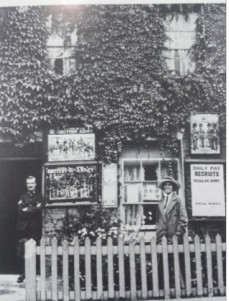 |
The roll of honour was introduced to increase recruitment. Stirring speeches were made outside the market hall in Redhill. There was also a march from Reigate through Meadvale, down the Brighton Road, up Station Road to Shaws corner. The result was deemed to be a success with 584 men recruited in 10 days. The local recruiting office was located in Ladbroke Road, Redhill where the station car park is now. Within three weeks of the declaration of war over 100,000 men in the United Kingdom had enlisted. During the war The East Surrey Regiment raised 24 battalions, with 1,000 men in each battalion. 21 saw active service. The casualties were horrendous, 6,223 officers and rank and file killed. |
Hospitals
|
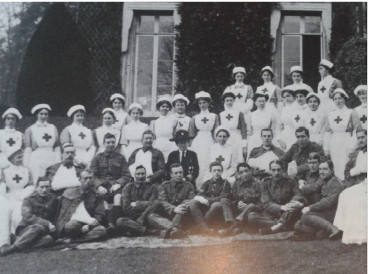 |
| Due to the high number of casualties, many large houses and buildings were turned into Hospitals during the war. The picture above shows Hillfield Redcross Hospital at 30 Raglan Road, Reigate the hospital was staffed by Reigate and Betchworth V.A.D’s. It had 50 beds in three wards named after military figures of the day Kitchener, French and Jellicoe. Miss Hemming was the matron. Patients were accepted from 10 November 1914 and 500 were treated in the first year. Netherne Hospital had to handle large numbers of patients from neighbouring hospitals, which had been taken over by the military. Food from the market garden contributed to national supplies and convalescent soldiers and German PoW were bought in to assist. By 1916 many of the staff at Royal Earlswood asylum had left to enrol in the Armed Forces. It had been hoped to employ women to make up the shortfall, but the munitions factory proved to be more attractive. The Institution applied for exemption from conscription for its remaining male staff. In 1917 the Institution contained 478 patients (318 males and 160 females) - the highest recorded in its history. |
Billeting of Troops
|
| Considerable numbers of soldiers were billeted in Redhill. Due to its importance as a railway junction, Redhill was made the headquarters of the troops on track and bridge guard duties in Surrey and Sussex. Many other soldiers were billeted whilst en route, some procuring horses and some training. In Redhill troops not billeted in houses camped on Redhill Common and other local open spaces. The Annual Report of 1914 from the Medical officer of Health for Reigate reported that by the middle of August there were 12,432 men and 1,467 horses along the railway line into Redhill. There were remount depots at Marketfield, Batts Hill and Cavendish Hill. Conditions for the young troops were difficult with many falling ill with disease before leaving the country. In September 2,480 military blankets disinfected from verminous conditions. The railway also brought troops to Tadworth and Tattenham Corner, where the goods sidings were much used. Bunks were put in the box waggons stabled in the platforms originally built for race meetings. Tadworth in 1914 just a few large houses and cottages became a vast tented camp with thousands of troops from battalions of the London Regiments being stationed on open farmland there for training. During the winter these troops were moved to quarters in private homes many of them in the Banstead area. Billeting officers knocked on every door and allocated troops depending on size of the house and number of residents. Some were not happy with their allocations, including parents with young daughters, although there was no question of refusing. Payment for board and lodging was two shillings and 6 pence (12.5p) a day. |
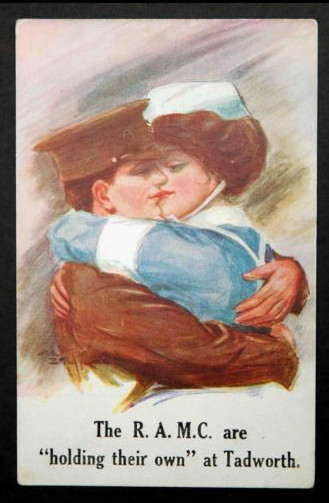 |
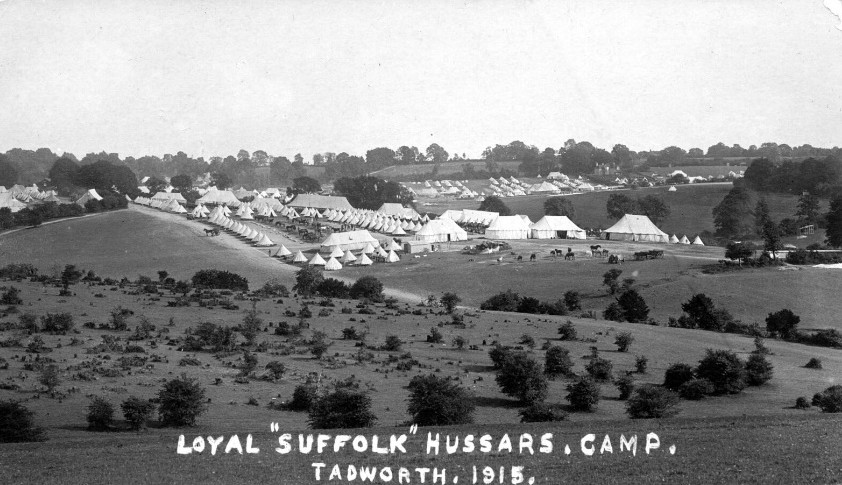 |
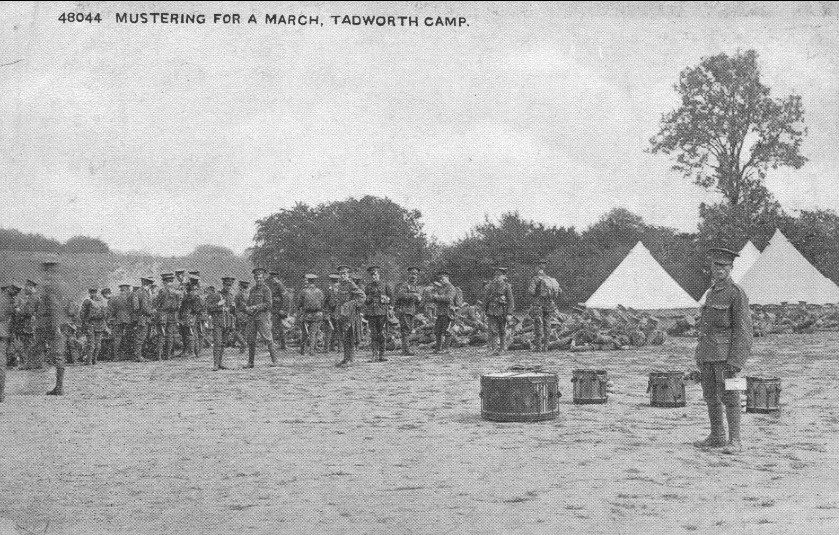 |
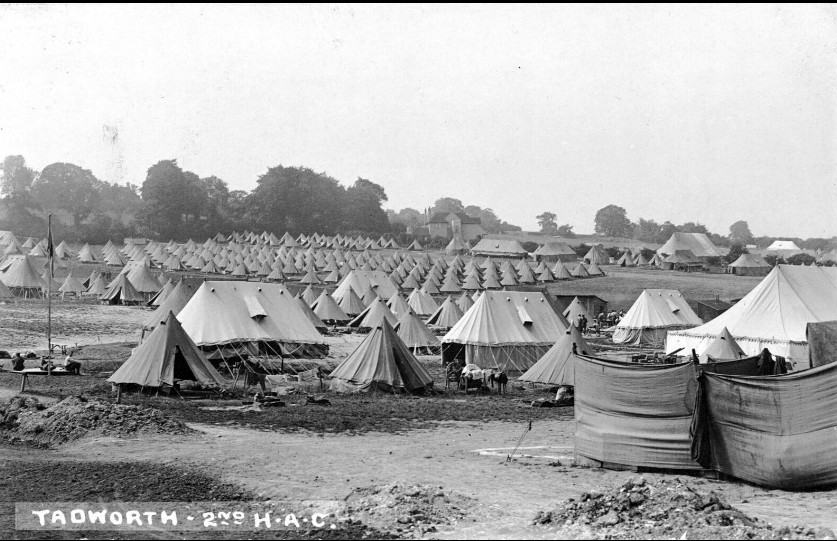 |
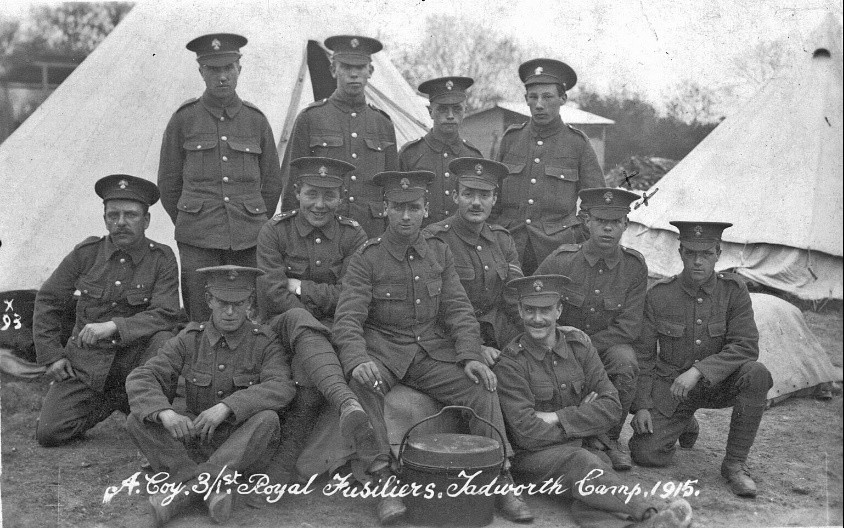 |
Key dates for 1914 |
|
|
|
| Banstead War Memorial |
|
| Banstead War Memorial lies at the eastern end of the High Street at the junction with Park Road. The building of the Memorial was initiated by the Banstead Parish Council, on whose behalf, Mr Ralph Neville of Banstead Place, wrote to the Epsom Rural District Council in March 1919. He stated that ‘it was desired to erect a Celtic Cross as a memorial to the villagers who had fallen in the 1914/18 War’. It took some considerable time to make the necessary arrangements, including the raising of a fund by public subscription. Mr Neville died in 1923 and left the sum of £250 to the vicar and churchwardens upon trusts which included a condition that they keep the memorial in repair "with the names clearly legible". It was unveiled by General Sir Charles Carmichael Monro on Sunday 5 June 1921. After the Second World War, the names of the villagers who died in that War were also inscribed on the memorial. There are now 118 names on it. In 2010 the Banstead History Research Group published a book about the stories behind the names. ‘These Men of Banstead’, was written by local resident Lewis Wood and it details the stories of 34 of the men. The stories introduce the reader into the rich and fascinating history of these men who fought for their country. Each account is complemented by personal and service photographs, images of mementoes and keepsakes, diary entries, and postcards and letters sent home, all the result of painstaking research over a period of four years by Lewis and other members of the Group. More information is available on their website http://www.bansteadhistory.com/ |
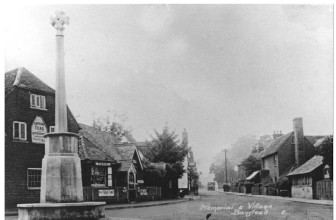 |
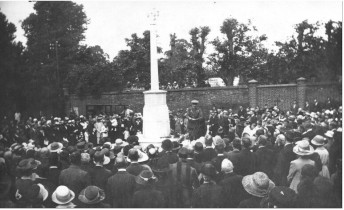 |
200 war graves
|
| We have surveyed cemeteries and churchyards up and down the borough and have so far identified around 200 War Graves, mostly belonging to servicemen and women who fought in the First or Second World Wars. A number of graves have headstones supplied and maintained by the Commonwealth War Graves Commission. Others are privately erected memorials, some of which no longer appear to be tended and are in a poor state of repair, with a few needing professional restoration. These repairs have been completed and we are now looking for volunteers to help maintain them. |
August 2014 anniversary
|
| Restoration of these War Graves before the August 2014 anniversary is of the upmost importance so we can give a fitting and lasting tribute to honour those that fought and died for us. Before we start work we are keen to trace as many relatives or friends of those buried in these graves as we can to let them know what we are planning but also to find out more about the people buried there and their remarkable stories. |
Involve local community
|
| We also want to involve the local community in this important project and so are looking for volunteers to help with ongoing maintenance of these graves. We are keen to hear from schools, youth groups, local organisations and businesses who would like to be involved in helping to keep them in a good state of repair over the years to come and create a legacy for future generations. |
'Adopt a grave' project
|
| The Council completed the restoration in June and some have been handed over to volunteer groups to take over the upkeep. The ‘adopt a grave’ project will involve keeping the grass neatly trimmed, the plot weeded, headstones and surrounds clean and generally maintaining it in good order. If you are interested in volunteering to maintain war graves, want to let us know about your own commemorative events, or have any interesting stories about World War 1 please let us know so they can be included in future editions. leisure@reigate-banstead.gov. |
| Our grateful thanks for their time, knowledge old postcards and input in collating this brochure: Patsy Shillinglaw (Poppy illustration), Andrew Thompson Horley History Society – Doug Cox, Peter Cox, Brian Bus Banstead History – Richard Mantle, Stuart Sweetman & Tony Goring Reigate & Redhill Toby Biggs, Alan Ingram, |
| In the next issue: find out about Rupert Price Hallowes from Redhill, who was awarded the Victoria Cross. Learn about conditions on the home front and the opportunities this provided for women in Horley. |
Reigate and Redhill Remembers
|
1914-1918 |
Volume 2 |
1915 |
|
||
Introduction |
 |
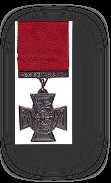 ….. quotes from Cllrs etc
….. quotes from Cllrs etcRupert Price Hallowes
Born in Redhill Rupert Price Hallowes was awarded the Victoria Cross for most conspicuous bravery and devotion to duty during the fighting at Hooge in Belgium between 25th September and 1st October, 1915. Second Lieutenant Hallowes displayed throughout these days the greatest bravery and untiring energy, and set a magnificent example to his men during four heavy and prolonged bombardments. On more than one occasion he climbed up on the parapet, utterly regardless of danger, in order to put fresh heart into his men. He made daring reconnaissances of the German positions in our lines. When the supply of bombs was running short he went back under very heavy shell fire and brought up a fresh supply. Even after he was mortally wounded he continued to cheer those around him and to inspire them with fresh courage.
It was the custom to offer a captured German gun to the home town of the recipients of the Victoria Cross as Rupert Prices Hallowes was born in Redhill, a Howitzer artillery gun was presented. The photo shows the gun positioned in front of the Moat house in April 1919. These guns were recalled in 1940 for the ‘war effort’ for the Second World War.
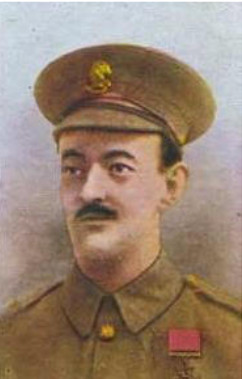 |
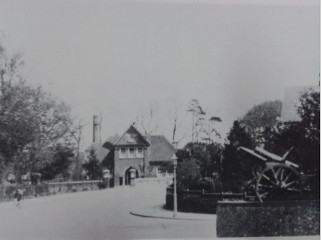 |
Horses in WW1 |
| When war began in 1914 the British army possessed a mere 25,000 horses. The War Office was given the urgent task of sourcing half a million more to go into battle. They were essential to pull heavy guns, to transport weapons and supplies, to carry the wounded and dying to hospital and to mount cavalry charges. In the first year of war the countryside was emptied of shire horses and riding ponies, a heartbreaking prospect for farming families who saw their finest and most beloved horses requisitioned by the government. Sangers Circus wintered in the fields that now form part of the Court Lodge estate in Horley. Their elephants were used to plough fields and as a means of transporting agricultural bundles from one farm to another due to the shortage of horses. |
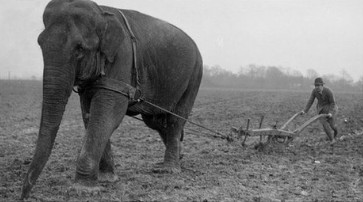 |
|
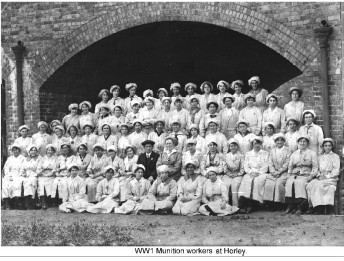 |
| Whist many of the men were away fighting the war, it was left to the women to keep up the war effort at home. This was often a genuinely liberating experience as it gave women the freedom and the wages only men had enjoyed so far. Approximately 1,600,000 women joined the workforce between 1914 and 1918 in Government departments, public transport, the post office, as clerks in business, as land workers and in factories, especially in the dangerous munitions factories, which were employing 950,000 women by Armistice Day (as compared to 700,000 in Germany). Number 35 munitions store located in Horley by the Railway station to allow the heavy shells to be easily transported. It filled almost 5 million 18 pounder shrapnel shells during 1916 & 1917 Munitions workers across the UK known as Munitionettes produced 80% of the weapons and shells used by the British Army and daily risked their lives working with poisonous substances without adequate protective clothing or the required safety measures. Women bus conductors can be seen in this picture from the Reigate and Redhill bus. |
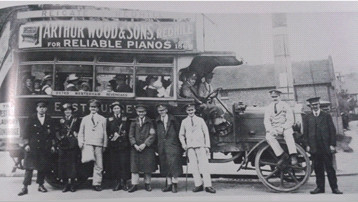 |
In Flanders Fields
|
| by John McCrae, May 1915 In Flanders fields the poppies blow Between the crosses, row on row, That mark our place; and in the sky The larks, still bravely singing, fly Scarce heard amid the guns below. We are the Dead. Short days ago We lived, felt dawn, saw sunset glow, Loved and were loved, and now we lie In Flanders fields. Take up our quarrel with the foe: To you from failing hands we throw The torch; be yours to hold it high. If ye break faith with us who die We shall not sleep, though poppies grow In Flanders fields. |
| This poem was written by McCrae whilst he was working at Essex Farm Advanced Dressing Station near Ypres. Private Valentine Joe Strudwick from Dorking and believed by many to be the youngest English soldier killed in the Great War, is buried at Essex Farm. Strudwick was only 15 when he was killed in January 1916. |
Key dates for 1915 |
|
Reigate and Redhill Remembers
|
1914-1918 |
Volume 3 |
1916 |
1916 |
 |
Introduction
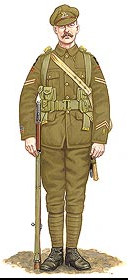 Reigate and Banstead Borough Council is very proud of the part that our residents played in the First World War and keen that their bravery is remembered. Between 2014 and 2018 the Council is planning a range of activities and events across the borough so that people of all ages can come together to mark, commemorate and remember the lives of those who lived, fought and died in the First World War. Reigate and Banstead Borough Council is very proud of the part that our residents played in the First World War and keen that their bravery is remembered. Between 2014 and 2018 the Council is planning a range of activities and events across the borough so that people of all ages can come together to mark, commemorate and remember the lives of those who lived, fought and died in the First World War.….. quotes from Cllrs etc The Queen’s (Royal West Surrey) Regiment paid a high price for its commitment in the First World War; 8,000 men were killed out of the twenty-five battalions. The Regiment gained five Victoria Crosses (VCs). In the 1st Battalion alone, five commanding officers, two majors, sixty-one company officers and 1,133. NCOs and men were killed in action. (Each battalion was about one thousand strong and was organised into a Headquarters, Company and four rifle companies). |
The Battle of the Somme |
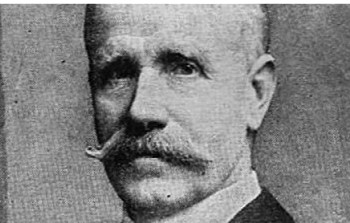 |
| In February the German army launched a massive assault on the French at Verdun and by the early spring the British were asked to attack the Germans to relieve the pressure. The attack was launched on July 1st when the British and French armies attacked the Germans by the river Somme. Despite an intense bombardment, the initial assault was a disaster with almost 60,000 British soldiers being killed or wounded on the first day. The battle dragged on during the hot summer of 1916 with both sides suffering huge casualties. Lieutenant Colonel Alfred Irwin – 8th East Surrey Regiment “I sanctioned the idea on condition that he and his officers really kept command of their units and didn’t allow it to develop into a rush after the ball. If a man came across a football, he could kick it forward but mustn’t chase after it. I think myself, it did help enormously, it took their minds off it.” |
| Henry Webber the oldest known soldier to die in WW1 Henry Webber Lived in Horley with his wife 4 sons and three daughters, he worked at the London Stock Exchange and was one of the original members of Surrey County Council and the first chairman of Horley Parish Council. He volunteered to serve under any capacity and was turned down due to his age as he was more than 20 years over the age limit, he was eventually given a commission on 26 July 1915. He wanted to serve alongside his three sons. Webber was accepted by the army, despite his age, when he offered to take 20 horses from the Tilburstow Hunt with him. His role involved helping in the build-up for the Somme offensive, which started on July 1st 1916. He and his unit were not involved in the initial attack, but took part in following actions, including the capture of La Boiselle on July 3rd 1916. On July 21st the 7th Lancs moved up to relieve a battalion in the front line near Marmetz Wood. That night Henry Webber took supplies as usual with the battalion transport. Leaving his men to unload the horses, he went over to where the commanding officer was talking to a group of officers. However, at that moment, the area - a mile or so east of Albert - came under attack and a shell landed nearby. Webber was among 12 men - and three horses - which had been hit, suffering a head wound. He was 67. His three sons returned safely from the war. |
Key dates for 1916 |
|
Reigate and Redhill Remembers
|
1914-1918 |
Volume 4 |
1917 |
1917 |
 |
Introduction |
| Reigate and Banstead Borough Council is very proud of the part that our residents played in the First World War and keen that their bravery is remembered. Between 2014 and 2018 the Council is planning a range of activities and events across the borough so that people of all ages can come together to mark, commemorate and remember the lives of those who lived, fought and died in the First World War. |
Key dates for 1917 |
|
Reigate and Redhill Remembers
|
1914-1918 |
Volume 5 |
1918 |
1918 |
 |
Introduction |
| Reigate and Banstead Borough Council is very proud of the part that our residents played in the First World War and keen that their bravery is remembered. Between 2014 and 2018 the Council is planning a range of activities and events across the borough so that people of all ages can come together to mark, commemorate and remember the lives of those who lived, fought and died in the First World War. | |
Royal Alexandra and Albert School
|
| 45 War Orphans are now being looked after in the School. Girls at the school have knitted 419 pairs of socks for wounded soldiers. |
| Sergeant-Major Richard Tobin Hood Battalion, Royal Naval Division “The Armistice came, the day we had dreamed of. The guns stopped. Four years of noise and bangs ended in silence. The killings had stopped.” “We were stunned. I had been out since 1914. I should have been happy. I was sad. I thought of the slaughter. The hardships, the waste and the friends I had lost.” |
Key dates for 1918
|
|
"Back"Wilfred Gibson (1878-1962)They ask me where I've been, And what I've done and seen. But what can I reply Who know it wasn't I, But someone just like me, Who went across the sea And with my head and hands Killed men in foreign lands... Though I must bear the blame, Because he bore my name. |

